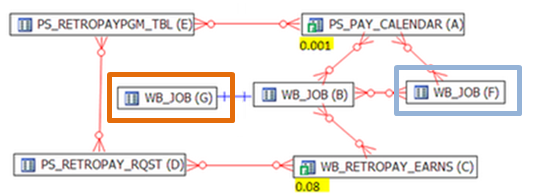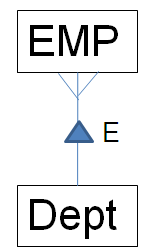Subquery Diagramming
Contents
Subquery Diagramming
- Simple join
- select * from a, b where b.f=a.f
- Non-correlated subquery is basically the same
- select * from a,
- (select b.f1 from b where b.f2=10)
- c
- where c.f1=a.f1
- What about aggregate non-correlated sub-queries/ They aren't exactly the same since they are more difficult rewrite as a regular join:
- select ename from emp, (select deptno from emp group by deptno having count(*) > 1) a where a.deptno=emp.deptno;
Single row subquery
- Special case, where non correlated subquery only returns one row
- select * from a where a.f1 =
- (select max(b.f1) from b )
- (laid out side by side because it acts as a filter not a master detail relationship)
- select * from a where a.sal >
- (select avg(sal) from b where b.f2=a.f2)
- Alternatively an arrow could be included to indicate that the subquery could be run for every row returned in the out query
- Is there a need to distinguish between aggregated correlated sub-queries and just correlates sub-queries.
Example
- SELECT
- A.COMPANY
- , A.PAYGROUP
- , E.OFF_CYCLE
- , E.SEPCHK_FLAG
- , E.TAX_METHOD
- , E.TAX_PERIODS
- , C.RETROPAY_ERNCD
- , sum(C.AMOUNT_DIFF) SUM_AMOUNT
- from PS_PAY_CALENDAR A
- , WB_JOB B
- , WB_RETROPAY_EARNS C
- , PS_RETROPAY_RQST D
- , PS_RETROPAYPGM_TBL E
- where A.RUN_ID = 'PD2'
- and A.PAY_CONFIRM_RUN = 'N'
- and B.COMPANY = A.COMPANY
- and B.PAYGROUP = A.PAYGROUP
- and E.OFF_CYCLE = A.PAY_OFF_CYCLE_CAL
- and B.EFFDT = (SELECT
- /*+ qb_name(wb_hj) */
- MAX(F.EFFDT)
- from WB_JOB F
- where F.EMPLID =B.EMPLID
- and F.EMPL_RCD# = B.EMPL_RCD#
- and F.EFFDT< = A.PAY_END_DT)
- nd B.EFFSEQ = a(SELECT MAX(G.EFFSEQ)
- from WB_JOB G
- where G.EMPLID = B.EMPLID
- and G.EMPL_RCD# = B.EMPL_RCD#
- and G.EFFDT = B.EFFDT)
- and C.EMPLID = B.EMPLID
- and C.EMPL_RCD# = B.EMPL_RCD#
- and C.RETROPAY_PRCS_FLAG = 'C'
- and C.RETROPAY_LOAD_SW = 'Y'
- and D.RETROPAY_SEQ_NO = C.RETROPAY_SEQ_NO
- and E.RETROPAY_PGM_ID = D.RETROPAY_PGM_ID
- group by A.COMPANY
- , A.PAYGROUP
- , E.OFF_CYCLE
- , E.SEPCHK_FLAG
- , E.TAX_METHOD
- , E.TAX_PERIODS
- , C.RETROPAY_ERNCD
- /
- I originally diagram this as
- but the subqeries are really only on G and F and the correlate with tables in the outside query:
Outer Joins
- If English and French both have a unique key on the "ordinal_id" then it's basically one-to-one relationship
- We add an arrow in the middle of the line to denote "outer join". The arrow points from the table that drives the join, ie all the rows in the table pointed from are returned even if a match isn't found in the table pointed to.
- above graphic originally on http://blog.mclaughlinsoftware.com/oracle-sql-programming/basic-sql-join-semantics/
In/Exists
Semi Joins
- SELECT *
- FROM dept d WHERE exists ( SELECT null FROM emp e WHERE e.deptno=d.deptno);
- SELECT *
- FROM dept d WHERE d.deptno in (SELECT deptno FROM emp e );
Not/Not Exists
- SELECT *
- FROM dept d WHERE not exists ( SELECT null FROM emp e WHERE e.deptno=d.deptno);
- SELECT *
- FROM dept d WHERE d.deptno not in ( SELECT deptno FROM emp e );












